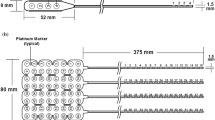Abstract
Stereo-electroencephalography (SEEG) provides a powerful tool for preoperative evaluation of patients with drug-refractory epilepsy, and can supply more quantified and systematic information for epilepsy surgeons. Precise localization of the electrode contacts is fundamental for the clinical evaluation based on SEEG. The difficulties of segmentation of the electrode contacts include handling the metal artifacts in post-implantation CT images, separating electrodes close to each other, and identifying the contacts belong to the same electrode. Here, we developed a pipeline for automatic segmenting the SEEG electrode contacts from post-implantation CT volume data. The pipeline mainly includes morphological closing determination (MCD), threshold-reduction region growing (TRRG), electrode enter point repair (EEPR) based on electrode geometric information, such as directions, angles, and distances, interconnected electrodes determination and separation (IEDS), and craniocerebral interference removing (CCIR). The robustness and generality of our algorithm was validated on 12 subjects (135 electrodes, 1812 contacts). Compared to the manual segmentation (240 contacts), automatic localization was more precise and 9 times faster. Moreover, the sensitivity was as high as 99.55% ± 0.60%, while the positive predictive value reached 95.25% ± 1.38%. In addition, our algorithm successfully separated 14 sets of interconnected electrodes, verifying the stability of accurately segmenting close electrodes. To provide more useful information about electrode contacts, we fused post-implantation CT images with pre-implantation MRI T1 images, and provided the structural and functional brain region of each contact using AAL atlas and Brainnetome parcellation. We also developed a friendly MATLAB-based graphical user interface (GUI) in which the pipeline was implemented.
Access this chapter
Tax calculation will be finalised at checkout
Purchases are for personal use only
Similar content being viewed by others
References
Bartolomei, F., et al.: Defining epileptogenic networks: contribution of SEEG and signal analysis. Epilepsia 58(7), 1131–1147 (2017). https://doi.org/10.1111/epi.13791
Scholly, J., et al.: High-frequency oscillations and spikes running down after SEEG-guided thermocoagulations in the epileptogenic network of periventricular nodular heterotopia. Epilepsy Res. 150, 27–31 (2019). https://doi.org/10.1016/j.eplepsyres.2018.12.006
Jehi, L.: Outcomes of epilepsy surgery for epileptic networks. Epilepsy Curr. 17(3), 160–162 (2017). https://doi.org/10.5698/1535-7511.17.3.160
Bartolomei, F., Chauvel, P., Wendling, F.: Epileptogenicity of brain structures in human temporal lobe epilepsy: a quantified study from intracerebral EEG. Brain 131(7), 1818–1830 (2008). https://doi.org/10.1093/brain/awn111
Proix, T., Bartolomei, F., Guye, M., Jirsa, V.K.: Individual brain structure and modelling predict seizure propagation. Brain 140(3), 641–654 (2017). https://doi.org/10.1093/brain/awx004
Jirsa, V.K., et al.: The virtual epileptic patient: individualized whole-brain models of epilepsy spread. NeuroImage 145, 377–388 (2017). https://doi.org/10.1016/j.neuroimage.2016.04.049
Qin, C., et al.: Automatic and precise localization and cortical labeling of subdural and depth intracranial electrodes. Front. Neuroinform. 11, 1–10 (2017). https://doi.org/10.3389/fninf.2017.00010
Meesters, S., et al.: Automated identification of intracranial depth electrodes in computed tomography data. In: 2015 IEEE 12th International Symposium on Biomedical Imaging (ISBI), pp. 976–979. IEEE, New York (2015). https://doi.org/10.1109/ISBI.2015.7164034
Arnulfo, G., Narizzano, M., Cardinale, F., Fato, M.M., Palva, J.M.: Automatic segmentation of deep intracerebral electrodes in computed tomography scans. BMC Bioinform. 16(99), 1–12 (2015). https://doi.org/10.1186/s12859-015-0511-6
Granados, A., et al.: Automatic segmentation of stereoelectroencephalography (SEEG) electrodes post-implantation considering bending. Int. J. Comput. Assist. Radiol. Surg. 13(6), 935–946 (2018). https://doi.org/10.1007/s11548-018-1740-8
Acknowledgement
This research is supported by a Union Grant of the Guangdong Province and National Natural Science Foundation of China (No. U1801265) and a grant from National Nature Science Foundation of China (No. 61403430).
Author information
Authors and Affiliations
Corresponding author
Editor information
Editors and Affiliations
Rights and permissions
Copyright information
© 2019 Springer Nature Singapore Pte Ltd.
About this paper
Cite this paper
Lin, Z. et al. (2019). A Robust Automated Pipeline for Localizing SEEG Electrode Contacts. In: Zeng, A., Pan, D., Hao, T., Zhang, D., Shi, Y., Song, X. (eds) Human Brain and Artificial Intelligence. HBAI 2019. Communications in Computer and Information Science, vol 1072. Springer, Singapore. https://doi.org/10.1007/978-981-15-1398-5_3
Download citation
DOI: https://doi.org/10.1007/978-981-15-1398-5_3
Published:
Publisher Name: Springer, Singapore
Print ISBN: 978-981-15-1397-8
Online ISBN: 978-981-15-1398-5
eBook Packages: Computer ScienceComputer Science (R0)




